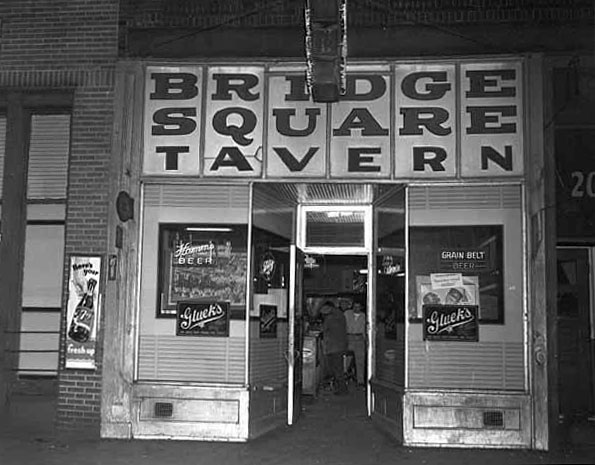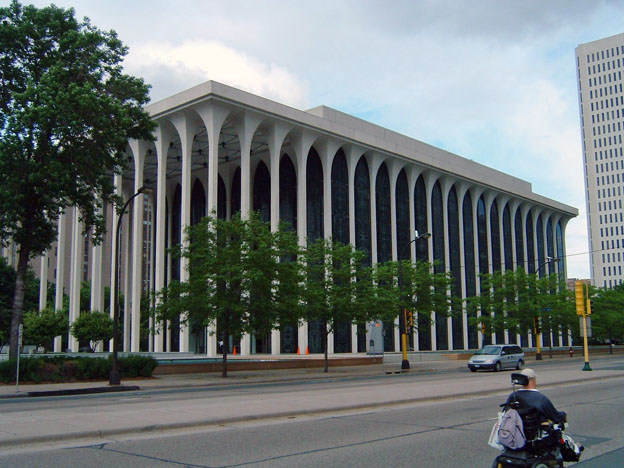Bridge Square Tavern
The Bridge Square Tavern was located at 209 Nicollet Ave., in the heart of Skid Row in Downtown Minneapolis.
Bridge Square was where Hennepin and Nicollet Avenues came together at the oldest part of the City, and where approximately 3,000 transient men lived in cheap hotels on pensions from working on railroads, lumber camps, and other rough-and-tumble jobs.
The area was one of only a few in Minneapolis where bars that sold liquor were allowed, according to the Patrol Limits ordinance, so there was an inordinate number of bars, taverns, and liquor stores in the area.
THE BUILDING
This particular building goes back to before 1888. Demolition notes give it a footprint of 21 x 119 x 38 ft. It was a 3-story brick building.
The upper floors were as a 15-room lodging house for men called (at least in the ’20s, ’30s, and ’40) as the La Salle Hotel. One of its early owners was Charles J. Budde.
Early uses of the ground floor are usually noted as a store, a saloon, or a lunch place.
On April 29, 1924, there was a fire in the basement that threatened to destroy the building. The newspapers reports told us that the hotel was called the La Salle and that the first floor held the Eureka Lunch.
From 1924 to 1925, a man named Hugo E. Blair had a Pool hall.
In 1926, W. Kalinsky had a City permit for soft drinks and lunch, pool.
From 1928 to 1932 it was Moore’s Restaurant, owned by T.J. Moore. From August 1929 to 1932 it was simultaneously for sale and advertising for waiters.
By February 1933, Einar and Emma Smith owned the Smith Restaurant.
THE BRIDGE SQUARE BAR
In April 1934, Harry Sobelman and Bessie Feldman received an on-sale liquor license and became the co-owners of the Bridge Square Bar. Bessie’s husband John was a bartender, but couldn’t be an owner because of the year-long stint he did at Leavenworth for a Prohibition violation in 1930. In May 1934, Harry and Bessie got permits for a restaurant, cigarettes and soft drinks, non-intoxicating malt liquor (on and off).
The joint was jumpin’ in 1935, apparently, when the Bridge Square Bar showed up in Walter Winchell’s fake column about where to go in the Twin Cities. I mean, has WW ever heard of Minneapolis? But someone wrote this copy in his unique patter:
The band at the Bridge Square Tavern is among the tops when it comes to torrid tootling – and when resting why not eat – and wel – well, drop in some evening when you’re out – and take a look – and a bite – and a dance. Mr. and Mrs. You-Know will very probably be there. (Minneapolis Tribune, November 15, 1935)
In February 1937, proprietor Harry was convicted for allowing employees to let a 16-year-old frequent the bar. He took it to the State Supreme Court and lost.
Probably as a result of the court case, in March 1937, the bar’s liquor license was transferred from Harry and Bessie to just Bessie. Bessie also got licenses for tavern, dance hall, restaurant, cigarettes and soft drinks.
For some reason the proprietor’s name in yet another crime story was given as Ben Feldman.
In November 1947, Bessie’s beer and liquor licenses were transferred to the Fraternal Order of Eagles, Minneapolis Aerie No. 34, 325 Second Ave. So.
And the Bridge Square Bar went under. In its 13 years, the Bridge Square Bar had more fights, robberies, sluggings (that was a technical term used then), beatings, and people with razor blades in their pockets to fill a book. It may not have been the worst place in the Gateway, but something about it made guys mad. And yet, there must have been women – there was music, there was dancing – even Walter Winchell said you could take your lady friend for a night out at the Bridge Square.
BRIDGE SQUARE TAVERN
November 1947 – Bernard Feitelsohn, a former bartender at the abandoned Bridge Square Bar, applied for a beer license. At first it was opposed by his local Alderman, but since it would just be a beer tavern, Bernard knew the territory, and he promised to clean the place up, the permit was approved.
One thing Bernard didn’t have was a dance hall license: on June 28, 1950, Bernard was charged with allowing dancing without one. He was also in trouble for serving minors. While visiting the Tavern, the morals squad took in seven people for drunkenness. A photo of the Unfortunate Seven being herded into the paddy wagon graced the Minneapolis Star the next day.
In September 1950, Bernard was caught by Federal Agents of the Department of the Interior, selling beer to Indians. This was no longer against Minnesota law but was still a Federal offense. On February 13, 1951, he was sentenced to six months in the Workhouse and fined $250. (Minneapolis Tribune, March 7, 1951) Bernard lost his beer license on March 9, 1951.
In 1951 the new proprietor was Lige Udell. The new license was granted under protest.
In March 1956, Sam E. Silverman was the proprietor. In June 1956 the Tavern was given a 10-day suspension by the court because a waitress had been found guilty of keeping liquor and wine at the 3.2 beer place.

Photo (@1947-1960) courtesy Minnesota Historical Society
In June 1959, the owner was identified as Mrs. Kathryn Chester.
DEMOLITION AND REBIRTH
The building was part of the ambitious Gateway Redevelopment Project, where 20 blocks of mostly old, obsolete buildings were torn down by the City of Minneapolis, with plans to rebuild newer and better buildings and infrastructure and resettle the 3,000 residents of the area. The demolition part of the plan was carried out, and some building was done, but to this day, some of the land that was cleared has remained barren.
In the case of the Bridge Square Tavern, the fixtures were sold in July 1960, and the demolition permit was pulled in October 1960. And the geography of the streets has changed, but if I’m reading the map right, in its place stands what was originally the Northwestern National Life Building, the symbol of what was supposed to be the New Gateway.

